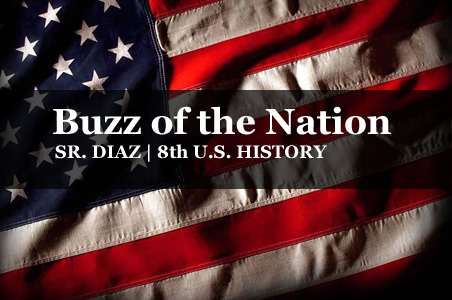Semester II
The U.S. goes continental
Thursday, December 20, 2012
Monday, December 17, 2012
Finals begin tomorrow, end Wednesday
Review question:
The two houses of the U.S. government is an example of English ____________ary tradition.
The two houses of the U.S. government is an example of English ____________ary tradition.
Friday, December 14, 2012
Semester 1 Final Review
Don't be left in the dark!
Study the major themes of American Influence, rebellion, Declaration of Independence, and the Constitution.
See the Study Guide here!
Study the major themes of American Influence, rebellion, Declaration of Independence, and the Constitution.
See the Study Guide here!
Thursday, December 13, 2012
No one named Whiskey here
Whiskey Rebellion
No one named Whiskey here.Watch and read the selections below to answer the following questions.
What similarities do Shays' Rebellion and the Whiskey Rebellion share?
How did the national government react differently in the Whiskey Rebellion than Shays' Rebellion?
Context: Transporting crops to market was long and tedious. Also, farmers could only carry a limited amount of grains to market at a time, before they would spoil. It was much more profitable to distill the grains into liquid (alcohol/whiskey) and then take it to market. This way, they could carry more in a wagon, make more money, and spoiling was not a problem.
The Whiskey Rebellion
Nearly twenty years after the revolutionary War began, the United States government faced a small-scale revolution by some of its own citizens. As in the previous war, taxes were a central issue. And Alexander Hamilton understood that putting down this rebellion was critical to the life of the nation.
In order to create a self-supporting and effective government, Treasury Secretary Hamilton knew he needed to find a steady source of revenue. He proposed an excise tax on whiskey produced in the United States, and Congress instituted the levy in 1791. In general, the citizens of that time felt negatively toward the idea of taxation. The farmers of western Pennsylvania, many of whom distilled whiskey and profited from its sale, proved outright hostile to the idea.
In July of 1794, a force of disaffected whiskey rebels attacked and destroyed the home of a tax inspector. The rebellion grew in numbers, if not in actions, and threatened to spread to other states. Hamilton knew that the presence of a large and potentially hostile force in Pennsylvania could not be tolerated. If the government were to survive, it would have to show itself capable of keeping control.
Hamilton advocated the use of military force; President George Washington instead put state militias on the ready and sent in negotiators. When talks proved fruitless, Washington acquiesced to Hamilton's view. A force of 13,000 militia troops, led by Hamilton and Virginia governor Henry Lee, marched into western Pennsylvania.
By the time the federal force arrived, the rebellion had collapsed and most of the rebels had fled. Two men were convicted of treason and later pardoned by Washington. Alexander Hamilton was elated. The fledgling federal government had proven it could keep order -- a necessity if the U.S. was to avoid instability. But many, in particular Thomas Jefferson, thought that this resort to military force was a dangerous mistake. It convinced them that Hamilton was a dangerous man.
Citation: http://www.pbs.org/wgbh/amex/duel/peopleevents/pande22.html
Wednesday, December 12, 2012
Who is Jefferson?
Review
Reviewed content from Chapter 8 and handed back Constitution Benchmark.
What document did he write?
What was his stance on rebellion during Shays' Rebellion?
What was his opinion on a central government?
Federalism - a system of government with shared power between states and central government.
Federalist believed in federalism, forming a stronger central government than the Articles of Confederation.
Is Jefferson a Federalist or Anti-Federalist?
What was his view on the Hamilton's national (central) bank?
Was Hamilton a Federalist or Anti-Federalist?
Read p.315-316 "Jefferson's Philosophy"
How did Jefferson believe Americans should live? Where should they live?
What name do you see in Jeffersonian and Jefferson Democratic Republicans?
His beliefs are reflected in the names Jeffersonian and Jefferson Democratic Republicans. They carry his name and his ideals.
Reviewed content from Chapter 8 and handed back Constitution Benchmark.
Who is Jefferson?
What are the ideals of Jefferson?What document did he write?
What was his stance on rebellion during Shays' Rebellion?
What was his opinion on a central government?
Federalism - a system of government with shared power between states and central government.
Federalist believed in federalism, forming a stronger central government than the Articles of Confederation.
Is Jefferson a Federalist or Anti-Federalist?
What was his view on the Hamilton's national (central) bank?
Was Hamilton a Federalist or Anti-Federalist?
Read p.315-316 "Jefferson's Philosophy"
How did Jefferson believe Americans should live? Where should they live?
What name do you see in Jeffersonian and Jefferson Democratic Republicans?
His beliefs are reflected in the names Jeffersonian and Jefferson Democratic Republicans. They carry his name and his ideals.
Tuesday, December 11, 2012
Homework/Announcements
Review and correct your Chapter 8 test. Find the correct answers in the book and write the page number next to the question you corrected. For the open response, include the missing information for the Great Compromise.
Finals next week!
Finals next week!
Monday, December 10, 2012
Hamilton vs. Jefferson
Today Jefferson and Hamilton go toe to toe. Who is upset? Who is hurt? Who dealt the coldest snap in this exchange?
"Big Bucks" Hamilton vs "Tree of Liberty" Jefferson
"Big Bucks" Hamilton vs "Tree of Liberty" Jefferson
How do you bind a nation together?
Subscribe to:
Posts (Atom)
